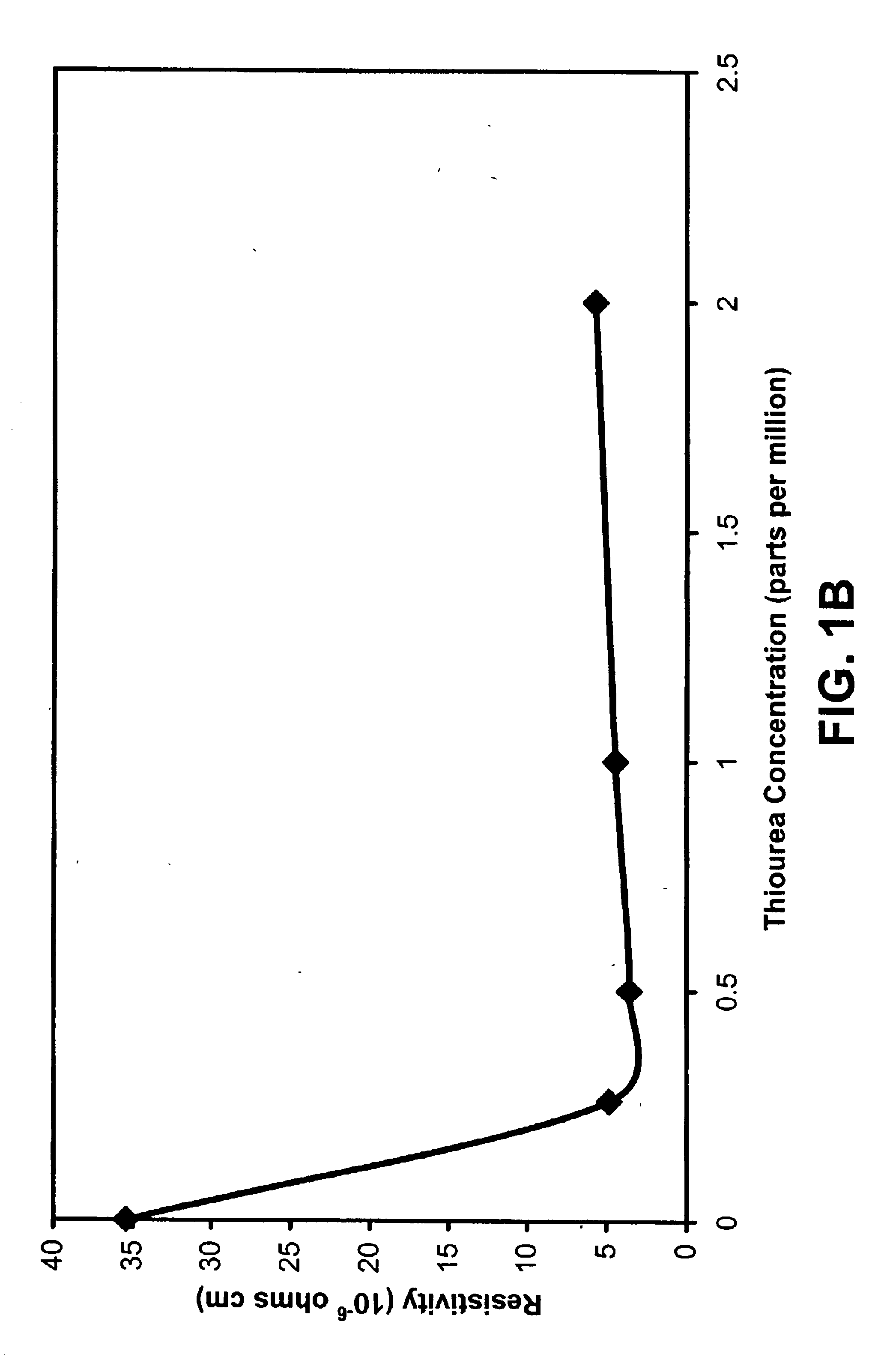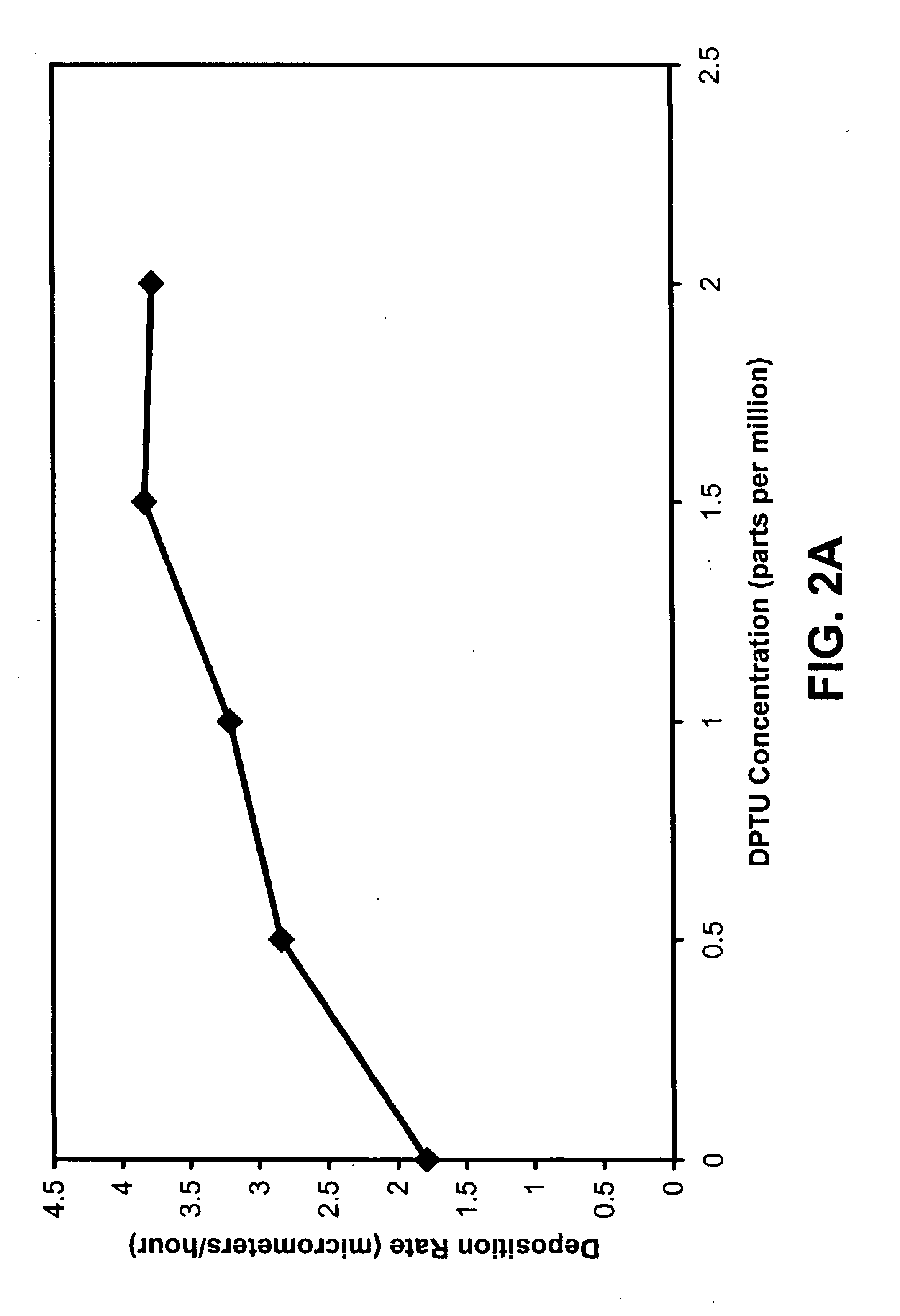Electroless copper plating solutions and methods of use thereof
a technology of electroless copper plating and copper plating solution, which is applied in the direction of liquid/solution decomposition chemical coating, solid/suspension decomposition chemical coating, coating, etc., can solve the problem that materials sensitive to higher (more basic) ph solutions cannot be used in electroless copper plating systems, and the need for electroless solutions has not been addressed in the industry. achieve the effect of accelerating the rate of copper deposition
- Summary
- Abstract
- Description
- Claims
- Application Information
AI Technical Summary
Benefits of technology
Problems solved by technology
Method used
Image
Examples
example 1
Example 1 discusses the use of thiourea (tu) and 1,3 diphenyl-2-thiourea (DPTU) to accelerate the electroless copper deposition process using HEDTA as the complexing agent and a hypophosphite as the reducing agent.
The composition and operating conditions of the electroless copper plating solution employed in Example 1 (less tu and DPTU) are summarized in Table 1.
TABLE 1CuSO4.5H2O0.04 MNaH2PO2.H2O0.12 MH3BO30.48 MNiSO4.6H2O 500 ppmPolyethylene Glycol 200 ppmHEDTA0.08 MpH 9.3T(° C.)70
HEDTA functions as the complexing agent for the copper (II) ions avoiding Cu(OH)2 precipitation, sodium hypophosphite (NaH2PO2.H2O) is the reducing agent, boric acid buffers (H3BO3) the electrolyte, polyethylene glycol is a surfactant, and nickel sulfate (NiSO4.6H2O) improves the catalytic effect of the deposition. Deionized water was used and the pH was adjusted using NaOH or H2SO4. Epoxy boards were used as the substrates for the electroless copper deposition. The epoxy boards were activated according t...
example 2
Example 2 discusses the use of formamidine disulfide dihydrochloride to accelerate the electroless copper deposition process using sodium citrate as the complexing agent and a hypophosphite as the reducing agent. Thiourea or its derivatives accelerate the deposition rate in the electroless copper plating solution using HEDTA as complexing agent, while they had little effect on the deposition rate and coating properties if sodium citrate was used as the complexing agent in place of HEDTA. Thiourea is oxidized to formamidine disulfide (fd) in HEDTA-electroless copper plating solution and fd has the same function as thiourea in HEDTA-electroless copper plating solution.
The composition and operating conditions of the electroless copper solution employed in Example 2 (less fd) are summarized in Table 2. Sodium citrate is the complexing agent for chelating the copper and nickel ions, and HEDTA is added to maintain the stability of fd. The functions of other chemicals are the same as descr...
PUM
| Property | Measurement | Unit |
|---|---|---|
| deposition rate | aaaaa | aaaaa |
| concentration | aaaaa | aaaaa |
| deposition rates | aaaaa | aaaaa |
Abstract
Description
Claims
Application Information
 Login to View More
Login to View More - R&D
- Intellectual Property
- Life Sciences
- Materials
- Tech Scout
- Unparalleled Data Quality
- Higher Quality Content
- 60% Fewer Hallucinations
Browse by: Latest US Patents, China's latest patents, Technical Efficacy Thesaurus, Application Domain, Technology Topic, Popular Technical Reports.
© 2025 PatSnap. All rights reserved.Legal|Privacy policy|Modern Slavery Act Transparency Statement|Sitemap|About US| Contact US: help@patsnap.com



